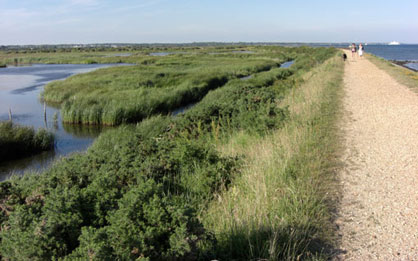| |
Lymington
to Keyhaven Nature Res. |
|

|
|
 |
|
| |
Description |
 |
 |
|
| The Lymington to Keyhaven Nature Reserve is an area of outstanding beauty and is made up of lagoons, reeds beds, salt marsh and mud flats. It supports a number of vulnerable plants and rare species and provides rich feeding grounds for a wide variety of birds, particularly during the spring and autumn migrations. The lagoons support nationally important breeding populations of little terns. There are also some excellent views across the solent to the Isle of Wight. |
 |
| Hampshire County Council had the foresight to purchased this area of coastline between 1973 and 2006 to protect its unique historical and wildlife heritage. The reserve covers an area of 500 acres, between the mouth of the Lymington river and the village of Keyhaven. The adjacent mudflats and salt marshes outside the seawall are leased by Hampshire and Isle of Wight Wildlife Trust and form their Keyhaven and Pennington Marshes Reserve. |
|
| |
| |
Salt history |
 |
|
| The coastline also has great historic significance. During the 18th century, Lymington was the biggest producer of sea salt in the country. The area between Lymington and Keyhaven was completely industrialised in the production of salt, with the greatest concentration of activity in the Oxey and Pennington marsh areas. Try to picture the countryside as it was then - with evaporating ponds for as far as the eye could see and billowing smoke from the boiling houses. There would have been boats delivering coal and taking away the salt, the air would have been thick with white salt dust and there would have been countless small windmills pumping the brine into the boiling houses. |
|
| |
| |
Birds |
 |
|
|
| |
| |
Contact |
 |
|
|
| |
| |
Directions |
 |
|
In Lymington, walk
along Bath Road, past the yacht clubs, around the Seawater Swimming
Pool and through the Haven Marina, from there a gate leads you
onto the coastal footpath. Streetmap
In Keyhaven, walk east
around the harbour until you come to a gate
leading to the coastal path. Streetmap |
|
| |
| |
Parking |
 |
|
| There are large
car parks in both Keyhaven and Bath Road, Lymington. |
|
| |
| |
Refreshments |
 |
|
| At the Lymington
end there is a cafe in
the Haven Marina, in Keyhaven there is the Gun
Inn and on Milford on Sea beach the Needle
Eye Cafe. |
|
 |
|
|
| |
|
|
| |
|
|
| |
| |
| |
| |
| |
